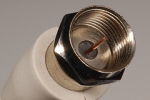D-Link Kit Allows Home Networking Using Coaxial Cable
PC World
http://blogs.pcworld.com/staffblog/archives/007024.html
05-28-08
D-Link has announced an Ethernet-to-Coax home networking kit coming later this year (Q3 2008) that will allow you to extend your broadband network to any room in your house that contains a coaxial cable connection. This technology is similar to power-line networking, which allows you to extend your network using the various power outlets scattered throughout your house. Both technologies theoretically allow for a more stable and reliable connection than Wi-Fi, with a range that's limited only by whether or not the rooms in your home have the correct outlets.
So what's the difference?
The main difference between power-line and coax networking seems to be that power-line networking is rated at "up to 200Mbps" in a perfect setting. Reliability of power-line networks can diminished by all sorts of factors such as the age of your home's wiring and interference from "devices that emit electrical noise, such as vacuum cleaners and hair dryers," according to the fine print found on one of D-Link's power-line networking products.
 Coax networking, on the other hand, offers actual throughput of 175Mbps, according to the Multimedia over Coax Alliance (MoCA).
Coax networking, on the other hand, offers actual throughput of 175Mbps, according to the Multimedia over Coax Alliance (MoCA).
A brochure on the MoCA site says, "MoCA only quotes net throughput numbers, as opposed to theoretical data rates, so the service provider and end consumer know exactly what to expect."
As far as reliability is concerned, it'll remain to be seen how well D-Link's device actually works, but the data is transmitted above the 850MHz range, while cable TV and cable Internet data are transmitted below 850MHz. Aside from that, you don't have a bunch of other stuff running through the coaxial connections inside your house like you do over your home's electrical wiring.
How does it work?
The D-Link kit, called the DXN-221, contains two adapters. One connects to your router and a nearby coaxial jack and the second one connects to a coaxial jack in another room and runs an Ethernet cable out to a nearby computer. You can add extra devices in other rooms too, provided those rooms have coaxial connections.
Downsides
One advantage that power-line networking has over coaxial networking is that you can find multiple electrical outputs spaced out relatively evenly in just about every room in your house. Coaxial connections aren't generally found in every room, and rooms that do have the coax jacks generally only have one or two that might not be ideally situated near your computer.
Also, at $200 for the starter kit, coax networking isn't exactly cheap. D-Link's power-line networking kit offers only marginal savings at $180. Additional connectors for D-Link's coax and power-line networking products cost $110 each, so you're looking at a pretty hefty investment.